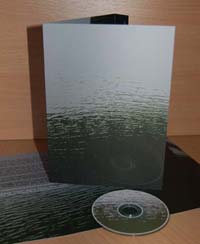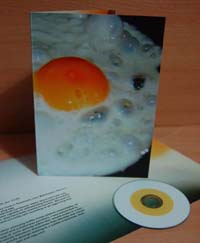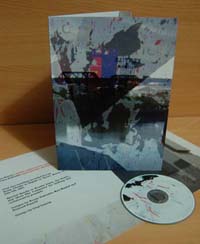I recently purchased all six of the vignettes series from Cathnor, due to a really great deal Richard was running on the Cathnor site. Cathnor has been a really great addition to the group of small labels covering this area of music, and I think a fairly distinctive taste is starting to show through, which I look forward to seeing develop more in time.
The vignettes series is currently comprised of 6 3″ CDRs, in very nice oversized packaging. Giving them the feel of some kind of audio postcard. They really (especially if you have all six) feel great to hold in your hands, and the larger format is successful in getting you to the place of absorbing the artwork as part of the experience. I’d be psyched if at the end of the series, Richard released a box for them or something, as it would seem fitting (at least to me).
Though I do have all six vignettes, I thus far have only really begun to internalize 2, due to being without a way to rip the CDs onto (or play them on) my computer.
The first is Bryan Eubanks, Ryu Hankil – 777
I have been a strong proponent of the nascent Korean improvised music scene since I first laid ears on them. There is so much experimentation going on there, and it is so well documented thanks to Balloon n Needle, the Manual, and Dotolim, that it is impossible to ignore. One of my favorite things about this scene, is the predilection towards the use of raw untreated mechanical sounds. In my mind it’s a necessary confrontation to a music which can still at times have a bit too much reverence for virtuosic technique.
One of my favorite purveyors of such sounds is Mr. Ryu Hankil. The seemingly gestureless, abstract clicks, whirs and metallic sputters of his clockworks create a world of music architecture, where micro compositions of small sounds become unique structures in a landscape. Tiny villages of sounds that one can live in for days, and still find mystery.
I was excited to hear that this outing paired Hankil and Brian Eubanks, as Eubanks back catalog bears some of my favorite releases in this area, his album “Anti-sex anti-wiretapping”, as half of GOD, is the favorite of what I’ve heard thus far.
So this was a big pairing for me, and I was really excited when my package from Richard, finally arrived. This was one of the first I listened to. The first and only piece on this disc starts out with some gentle small rattles from Hankil, and some nice textured static from Eubanks soon finds it’s way in and so the first two or so minutes of the piece are going along nicely. Hankil then switches up to a slightly different metallic texture, and Eubanks heads into a distant nineties ambient techno kind of bleeping, blooping thing. The quality of this sound is akin to something one may find on a “Techno Sound Effects of the Late Nineties” sample disc. I have to say this unfortunately sets the tone for much of the rest of the disc.
Now, I really was positive I was going to love this pairing, and I’m sure many others still will, but I have to say that Eubanks’ playing on this just does not go down well for me. If there are two things that I have no interest in hearing, one is the very transparent use of effects to create “ambience” or some sense of emotional/spiritual density, and two is thematic repetition. And Eubanks’ performance seems to be all about these things.
It’s not that he doesn’t do a good job, he does in many ways, but all I can hear are echos of Raster-Noton (and some less tasteful references) from 5-10 years ago. The question for me is, why rehash these specific sounds? Especially knowing what Eubanks is capable of. One of the things that makes the aforementioned GOD record a joy is the way in which effects are deployed in a somehow non-schlocky way, a very difficult feat seemingly pulled off with ease. But here, largely we hear what sound to these ears like the classic trappings of digital technology.
That all said, there is a lot about this record that still holds my interest. The brief moments where Eubanks eschews the ambient bloops for grainier, more tumultuous territory are really worth hearing. And Hankil, even in the midst of somewhat hostile environs, manages to pretty much play exactly what will add the right edge to stop things going into “Ambient Chillout volume 258” territory. It gives a clue as to the potential of this pairing which is imo, is just hinted at here.
It sucks to have to give this one a so-so review, as I really do want people to support Cathnor, but all in all, this one is not my cup of tea, though Hankil’s contributions I’m sure will keep me coming back, and perhaps I will at some point see through Eubanks’ playing, and find some hidden joy. If I do, I’ll be sure to report back here.
Stay tuned, I plan to review this whole series, and by far this is the one I’m most uncertain of.
Next up, Lee Patterson’s “Egg fry #2”.








The continued evolution of this blog | Some recent inspiration
July 3, 2009This blog started out initially with an idea, but no real plan. And as I’ve carried on, things have changed and the initial idea, no longer really suits me. I think about this blog all the time. It seems every weekend almost, I plan to write but I hardly do. I’m less interested in some of what I used to do, and more interested in other things. I’m busier. I got promoted at my job, and my wife and I bought a new house and moved into it. All the time though, I think of this blog and how I can post better and more often.
A perceived need to continue on in the initial spirit of this blog is one of the things that made it so hard to come back. For one, almost every post in the past contained something I had recently recorded. While I still plan on dropping the occasional random recording on here, my focus in recording has gotten much more specific. I have also slowed down in my production/collection of new gadgets for reasons I have addressed before. This can no longer really be the blog of random happy sounds that it used to be.
While it seems like I may have stopped doing a bunch of things (and this is true) my musical pursuits have gained in other ways. I have become interested in a lot of new music and have been seeing some great shows. I have also met some new people whose ideas have influenced mine for the better (I hope). Since I’ve been gone a while, here’s a little list of the things that have been on/in my mind for the past few months.
The Watchful Ear – This is the blog of Richard Pinnell. A far more ambitious blogger than myself, he writes about music every day, and his blog is something I come back to almost as often. Richard has the fortune of finding himself sat right on top (or perhaps just to the side) of one of the most fertile improvised music communities anywhere these days. And he writes about it in such wonderfully thoughtful detail, it makes me want to catch the first plane to London. He also does a ton of reviews. Over the last few months he has saved me a bunch of money, as due to the quality and quantity of his reviews, there is no real reason to purchase the WIRE anymore (ok, I’m kinda joking). Really, I think his blog is one of the things people in the future will look back on, and say wow thank God for that.
Dotolim – Dotolim is (from what I understand) and improvised music series in Seoul, Korea. It is organized by Jin Sangtae and seems to take place about once a month. It features mainly musicians from Seoul, but there are occasionally guests from Japan and the states. The best thing (for someone not based in Seoul) is that they video record, almost every set, and they are available on youtube. In a grenre of music that seems for some reason relatively distant from the benefits of modern internet technology, this is a real treat.
The format is relatively simple. Each night there are 2 – 3 sets featuring different combinations of players, and occasional solos. Since the Seoul scene is relatively small there are a few recurring players, and it has been interesting seeing how there approach changes with different partners or playing devices. Overall a great window into a scene that is very exciting right now.
Philly Sound Forum – PSF is an improvised and experimental music series that takes place in Philadelphia and is curated by Jesse Kudler and Ian Fraser. We had talked on occasion about how there were opportunities for very exciting musicians to play Philadelphia, that were not being taken advantage of by some of the other music series in the area. And how there were some smaller scenes in the surrounding areas that were worth attention as well, and yet not getting much. So Jesse and Ian got together to just do it themselves, and thus far it has been great. Based on some inspiration from dotolim, they also have made an effort to put as much documentary content about each show on the website that they can, and there is some excellent music and video offered there for free. I’m always looking forward to new PSF show announcements.
Another thing we have been discussing is some form of improvised music workshop, which hopefully will come to pass within the next few months. While we are still working out the details, I will say that the general idea is to 1) allow more opportunities for improvising musicians in the area to play 2) to open communication between musicians in the area and encourage dialogs that will help us hone our craft. 3) ?????…. we are still figuring it out, but keep coming back, I will be posting about it as it takes shape.
I could go on here, but I’ve already run on longer than I wanted to. I will continue in the next month of this blog to highlight things that have made an impact on me. They may just be mentions and urls, and they may be full reviews. More in a while…
Tags:improvisation, music commentary
Posted in music, reviews | 3 Comments »